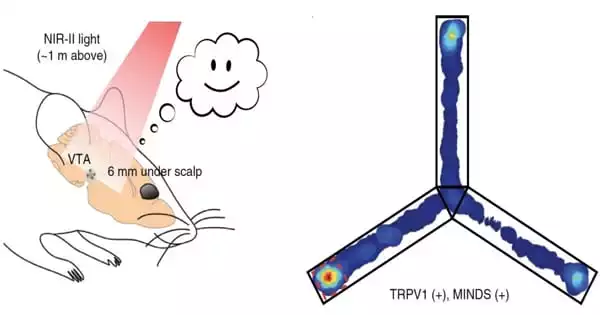Scientists have created the first non-invasive technology for remotely directing specified brain circuits in behaving animals. The technology has the ability to address one of the most pressing unmet requirements in neuroscience: a method for testing the functionality of specific brain cells and circuits deep within the brain during normal behavior.
Consider the brain to be a massive switchboard with thousands of buttons, knobs, dials, and levers controlling components of our thought, emotions, behavior, and memory. (Think of the movie Inside Out if you want.)
Neuroscientists have been painstakingly switching these switches on and off, alone or in combination, for more than a century to try to comprehend how the machine operates as a whole. However, this is easier said than done. The cellular circuits that regulate our minds and behaviors tangle together across the opaque, gelatinous mass of our brain tissue and lack convenient on/off switches for easy reverse engineering.
Scientists at Stanford University’s Wu Tsai Neurosciences Institute have created the first non-invasive technology for remotely directing particular brain circuits in behaving animals. The instrument has the potential to address one of neuroscience’s most pressing unmet needs: a mechanism to evaluate the activities of specific brain cells and circuits deep within the brain during normal behavior, such as mice freely interacting with one another.
Guosong Hong and colleagues at Stanford and Singapore’s Nanyang Technological University published their findings in Nature Biomedical Engineering. Hong is a Wu Tsai Neurosciences Institute Faculty Scholar and an assistant professor of materials science and engineering in the Stanford School of Engineering. He leverages his experience in chemistry and materials science to develop biocompatible technologies and materials to promote brain research.
The newly published technique builds on the foundation laid by optogenetics, a technique first developed at Stanford by Wu Tsai Neuro affiliate Karl Deisseroth and collaborators that introduces light-sensitive algal proteins into neurons, allowing researchers to turn them on or off in response to different colors of light.
We tried activating cells with TRPV1 channels alone first, and it didn’t work at all. Rattlesnakes, it turns out, have a lot more sensitive means of detecting infrared signals than we could in the mouse brain. We were fortunate to have materials science on our side.
Guosong Hong
“Optogenetics has been a transformative tool in neuroscience,” Hong said, “but there are limitations to what can be done with existing techniques, due in part to their reliance on visible light. Because the brain is highly opaque to visible light, getting the light to the cells you want to stimulate usually necessitates intrusive optical implants that can cause tissue damage and skull-mounted fiber optic tethers that make studying many types of natural behavior difficult.”
Thinking about ways to overcome these limitations as a materials scientist, Hong discovered that biological tissues, including the brain and even the skull, are essentially transparent to infrared light, which could allow the light to go much deeper into the brain.
Because traditional optogenetic instruments do not respond to infrared light, Hong’s team resorted to a molecule that evolved to sense the other form of infrared light: heat. His team discovered that by artificially outfitting certain neurons in the mouse brain with a heat-sensitive protein called TRPV1, they could excite the changed cells by projecting infrared light through the skull and scalp from up to a meter away.
TRPV1 is a molecular heat sensor that allows us to feel heat-related pain as well as the fiery burn of a chili pepper, and its discovery resulted in the Nobel Prize in Medicine in 2021. A similar receptor gives rattlesnakes and other pit vipers “heat vision,” allowing them to hunt warm-blooded food in the dark, and a recent study succeeded in providing mice infrared vision by introducing TRPV1 into their retinal cone cells.
The novel technology also makes use of an engineered “transducer” molecule that can be injected into specific brain regions to absorb and enhance infrared light passing through brain tissue. These nano-scale particles, known as MINDS (for “macromolecular infrared nanotransducers for deep-brain stimulation”), function similarly to the melanin in human skin, which absorbs harmful UV rays from the sun, and are made from biodegradable polymers used to make organic solar cells and LEDs.

“We tried activating cells with TRPV1 channels alone first, and it didn’t work at all,” Hong explained. “Rattlesnakes, it turns out, have a lot more sensitive means of detecting infrared signals than we could in the mouse brain. We were fortunate to have materials science on our side.”
Hong’s team initially showed their technique by inserting TRPV1 channels into neurons on one side of the mouse motor cortex, which orchestrates body motions, and then injecting MINDS molecules into the same region. The mice initially explored their enclosures at random, but when the researchers turned on an infrared light over the cage, the mice instantly began wandering in circles, fueled by one-sided stimulation of their motor cortex.
“That was a fantastic moment when we realized this was going to work,” Hong added. “Of course, it was merely the beginning of validating and evaluating what this technology might achieve, but I was convinced we had something from that point on.”
Another important work demonstrated that MINDS might permit infrared stimulation of neurons throughout the entire depth of the mouse brain. They implanted TRPV1 channels into dopamine-expressing neurons in the brain’s reward centers, which are located towards the base of the brain in mice, and then injected MINDS into the same location. They next concentrated an infrared light on one of the three arms of a conventional radial arm maze and demonstrated that mice were “addicted” to the invisible infrared light tickling their dopamine neurons, spending nearly all of their time in the maze under its beams.
This experiment proved that the novel technology allows for the stimulation of neurons anywhere in the brain via the intact scalp and skull – with little of the light scattering that would make this impossible with light in the visual spectrum. Surprisingly, this worked even when the infrared light beam was positioned up to a meter over the animals’ heads.
Hong sees immediate uses for the technology in the rising neuroscience movement to research the brain circuits involved in natural social behavior in mice in order to better understand the mechanisms that underpin human social cognition.
“Mice, like us, are a sociable species, yet analyzing an animal’s natural behavior inside a social group with a head-mounted fiber-optic cable is difficult,” Hong said. “For the first time, this approach allows for the modulation of specific neurons and circuits in freely behaving animals; simply shine invisible infrared light over an enclosure with cohoused mice to study the contributions of specific cells and circuits to an animal’s behavior within a social group.”
Hong and his colleagues are still refining the process to make it simpler and easier to deploy, he said. “In the future, we’d like to integrate our current two-stage technique into a single molecular machine, possibly by encoding some infrared-absorbing pigment into TRP-expressing neurons.”
This is one of several ways Hong is working on to allow researchers – and potentially one day clinicians – to non-invasively regulate neuronal networks across the brain. Hong and colleagues, for example, are developing nanoscopic beads that can convert concentrated ultrasound beams into light and can be injected directly into the bloodstream, allowing optogenetically targeting cells anywhere in the brain and changing this targeting at will within a single experiment.
“Conventional neuromodulation procedures allowed us to flip a few switches in the brain at a time to study what different circuits do,” Hong explained. “Our goal is to take these techniques a step further to give us precise control over the entire switchboard at the same time.”





